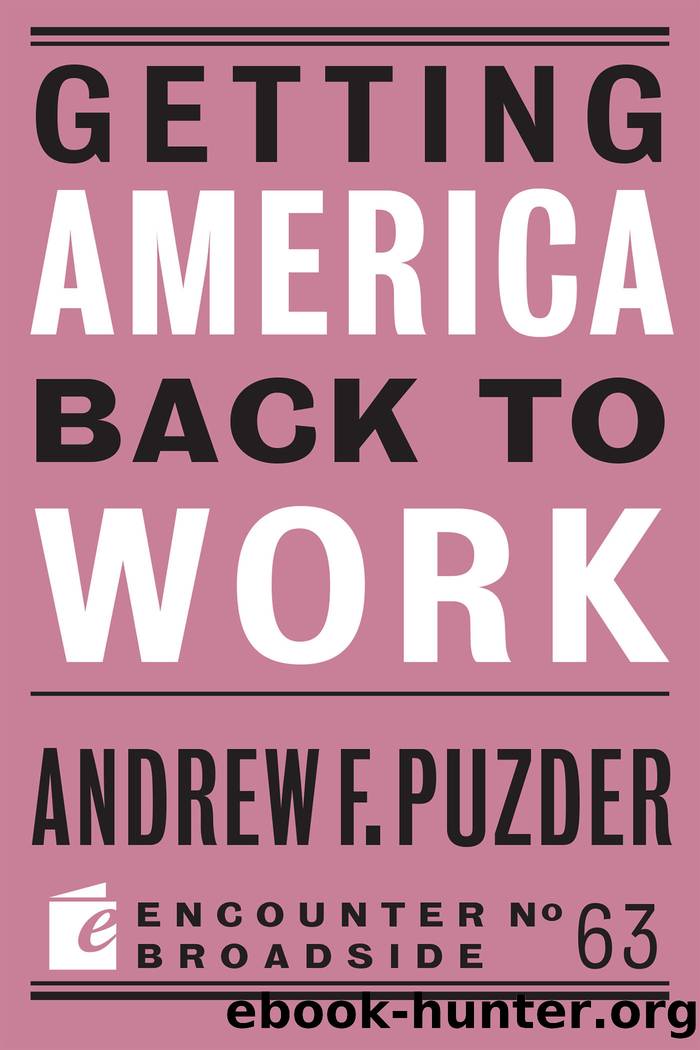Getting America Back to Work by Andrew F. Puzder

Author:Andrew F. Puzder
Language: eng
Format: epub
Publisher: Encounter Books
Published: 2020-01-15T00:00:00+00:00
While President Obama increased taxes, President Trump and the Republicans cut them. On December 22, 2017, Trump signed the Tax Cuts and Jobs Act. It reduced tax rates for individuals and businesses, made Americaâs corporate tax rate competitive with that of other nations, increased individual deductions and credits, increased the exemption for estate and gift taxes, and repealed the Affordable Care Actâs individual mandate.
The labor market rapidly responded.
In March of 2018, the unemployment rate hit 4 percent for the first time in eighteen years. It would remain at or below 4 percent for the next twenty-four consecutive months, consistently hitting fifty-year lows of 3.5 percent to 3.7 percent from April of 2019 through February of 2020.
The strong labor market helped everyone. In 2019, unemployment hit lows not seen since the government began reporting the data for African Americans, Hispanics, Asians, and people with only a high school education. For women the unemployment rate hit a sixty-five-year low, and for teenagers (aged 16â19) it hit a fifty-year low.
Unlike the Obama years, this decrease in the unemployment rate was not caused by people dropping out of the labor force. To the contrary, while Baby Boomers were undoubtedly still retiring, labor participation increased under Trump from 62.7 percent in January of 2018 to 63.4 percent by February of 2020.
Perhaps most notably, also beginning in March of 2018 and continuing for the next twenty-four months, there were more job openings than people unemployed for the first time since the government began reporting the data. For seventeen of those months, there were over 1 million more job openings than people unemployed â a record that may never be equaled.
This was a very significant and dynamic change from the Obama era. When Obama left office, there were 1.9 million more people unemployed than job openings. A mere thirteen months later, job openings exceeded people unemployed for the first time and by 372,000. By July, job openings exceeded people unemployed by 1.1 million. In February of 2019 (the most recent month for which we have the data), there were still 1.1 million more job openings than people unemployed.
When employees compete with each other for a limited number of job openings, as they did under President Obama, wages stagnate or decline. When employers are competing for employees to fill job openings, as was the case under President Trump, wages increase.
As a result, in August of 2018 yearly wages increased 3 percent for the first time since April of 2009. They didnât stop there. Wages increased 3 percent or better for twenty consecutive months. The long-anticipated wage growth economists expected during the Obama years had finally arrived, nineteen months after Obama left office.
The bottom line is that a little more than a year after Trump took office, we went from an economy where the biggest problem was workers being unable to find good paying jobs to one where the biggest problem was businesses being unable to find enough workers.
Wages increased most significantly for blue-collar workers. A December 2018 report
Download
This site does not store any files on its server. We only index and link to content provided by other sites. Please contact the content providers to delete copyright contents if any and email us, we'll remove relevant links or contents immediately.
| Anarchism | Communism & Socialism |
| Conservatism & Liberalism | Democracy |
| Fascism | Libertarianism |
| Nationalism | Radicalism |
| Utopian |
The Secret History by Donna Tartt(18951)
The Social Justice Warrior Handbook by Lisa De Pasquale(12170)
Thirteen Reasons Why by Jay Asher(8848)
This Is How You Lose Her by Junot Diaz(6836)
Weapons of Math Destruction by Cathy O'Neil(6220)
Zero to One by Peter Thiel(5736)
Beartown by Fredrik Backman(5682)
The Myth of the Strong Leader by Archie Brown(5461)
The Fire Next Time by James Baldwin(5386)
How Democracies Die by Steven Levitsky & Daniel Ziblatt(5175)
Promise Me, Dad by Joe Biden(5116)
Stone's Rules by Roger Stone(5053)
A Higher Loyalty: Truth, Lies, and Leadership by James Comey(4909)
100 Deadly Skills by Clint Emerson(4882)
Rise and Kill First by Ronen Bergman(4741)
Secrecy World by Jake Bernstein(4703)
The David Icke Guide to the Global Conspiracy (and how to end it) by David Icke(4658)
The Farm by Tom Rob Smith(4468)
The Doomsday Machine by Daniel Ellsberg(4452)
